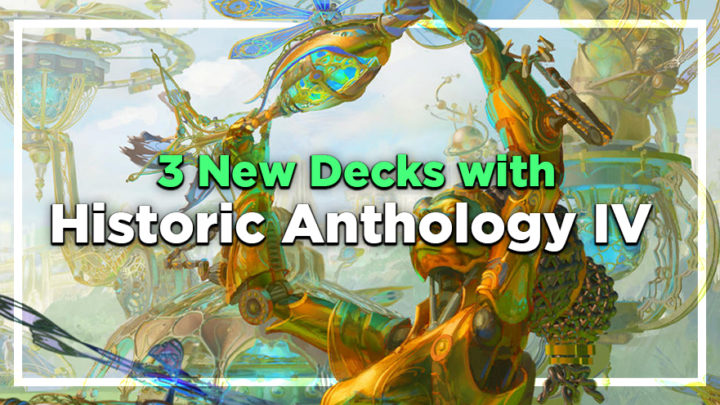I’m not much of a brewer, but ever since Historic Anthology IV was announced, I’ve been anxiously building new Historic decks. There are plenty of exciting new cards in the set — if you haven’t yet, check out Mason Clark’s article about some of the best cards to add to your Arena collection.
Today, I have three new decks to share with you, and I think they all have the potential to be big contenders in Historic going forward.
Mardu Cycling
Cycling is one of Magic players’ favorite mechanics, so it’s no surprise to see the hype around new cards that support it. There are two new cards for cycling decks in this Historic Anthology: Flameblade Adept and Faith of the Devoted. As I was building this deck, I realized that there are many different ways you could craft a cycling deck because there are powerful finishers in every color. For today, I’m going to introduce Mardu Cycling.

When I first saw that Flameblade Adept would be entering Historic, I immediately wanted to port over Hollow One from Modern. Unfortunately, most of the cards in that deck are not legal in Historic, so my next move was to combine the best parts of Standard Cycling and Hollow One. Between cycling cards, discarding cards, and drawing more cards, there are still a lot of ways to fuel your Zenith Flares while being able to power out Hollow Ones as early as turn three.
Ideally, with this deck, you’ll want Flameblade Adept or Flourishing Fox on turn one so you can start getting aggressive and pushing damage on turn two. Most of your other cards are to be used as cyclers, but you can cast some of your cycling spells depending on how the game progresses. For example, if you’re playing against Azorius Control, you might want to cast Memory Leak instead of cycling it.
The coolest thing about this deck is how many options you have during a game. You can attack with aggressive creatures, Zenith Flare your opponent for lethal, or sneak in a lethal attack with Flameblade Adept after casting Heartwarming Redemption. I decided to include Heartwarming Redemption in this build because it pairs very well with Hollow One and Shadow of the Grave, along with Flameblade Adept. I haven’t seen any cycling decks utilize this card so far, but it seems perfect if you’re trying to make a Hollow One build work.
Faith of the Devoted is another card to consider for this type of deck, but I was having trouble making it work. There are few games where you’ll want to slow down enough to pay a mana to active Faith of the Devoted when you cycle a card. This deck is much more aggressive, but I might give Faith of the Devoted a try in a different build of cycling further down the line.
Mono-Blue Storm
Since the release of Kaladesh Remastered, I’ve tried a couple versions of the old Standard Mono-Blue Storm deck. However, one key card in this archetype was left out of Kaladesh Remastered: Inspiring Statuary. Luckily, Inspiring Statuary has been included in Historic Anthology IV. There are a lot of fun combos and interactions you can string together, but most of them end with playing Aetherflux Reservoir and winning with its ability.

Let’s start with the basics of how this deck works. First, you want to cast a bunch of low-costed spells, such as Mox Amber and Ornithopter. Then, you want to resolve Inspiring Statuary so you can use your cheap artifacts to help cast Paradoxical Outcome. Paradoxical Outcome will allow you to return those artifacts back to your hand and draw cards. Eventually, you’ll be able to cast any spell in your deck and win with Aetherflux Reservoir.
Since Kaladesh, there have been many new cards printed that fit right into this deck — so many, in fact, that I struggled to narrow down the list of cards to include. But I eventually arrived at a build that feels consistent and whose power level is strong enough for Historic.
Emry, Lurker of the Loch was the first post-Kaladesh card I put into this deck. Emry will almost always cost only one blue mana in this deck, and it can also turn on Mox Amber as soon as turn one. Additionally, with Paradox Engine out, Emry makes infinite blue mana with two Mox Ambers, which you can use to draw every card in your deck with Chromatic Sphere.
The other major change I made was adding Karn, the Great Creator to the deck and a Karn wishboard to the sideboard. Karn is powerful in this deck because he can grab any card you could possibly need — a hate card for your opponent’s deck, like Grafdigger’s Cage, or a card for your combo, like Paradox Engine, Aetherflux Reservoir, or Mystic Forge. Paradox Engine is best with Emry, Mox Amber, and the creatures you tap for improvise with Inspiring Statuary. Aetherflux Reservoir is the main win condition, but you can also make a large number of thopters with Sai, Master Thopterist if winning with Aetherflux Reservoir is not an option. If you are going the Sai route, you can grab Akroma’s Memorial with Karn to give all your thopters haste and swing for lethal.
I’ve also upgraded the original artifacts from Kaladesh with some of the most efficient options in Historic, such as Chromatic Sphere and Golden Egg. Additionally, I added Mystic Sanctuary to the deck to return Paradoxical Outcome to the top of the library, in case you need to draw more cards or increase your storm count. There aren’t many ways to hate this deck out of Historic, and it’s resilient and versatile enough that I expect it to jump to the top of the metagame before long.
Rakdos Death’s Shadow
Last, but certainly not least, Death’s Shadow is one of the biggest additions to Historic in this Anthology set. I anticipate Death’s Shadow is going to be the most brewed-around card from this expansion, and there are a lot of different decks I want to build with it, too! For today, I want to share the version I think will be the best and most popular: Rakdos Shadow.

Getting card selection and numbers correct is really difficult with these kinds of decks, and I’m sure I will make even more changes after I get the opportunity to play this on the Arena ladder. For now, I am very happy with where I landed as a starting point.
I started off by dedicating some time to building the deck’s mana base. Mana bases are one of the most important parts of any deck, but in Death’s Shadow, your lands are also tools for managing your life total. Four Agadeem’s Awakening and three Shatterskull Smashing help get your life total down very quickly, in addition to four Blood Crypts. After that, you have the option to pay more life every turn if you have Ramunap Ruins or Ifnir Deadlands in play. All of these lands are the easiest way to turn on your Death’s Shadow as quickly as possible, but I also wanted to have the option to avoid taking damage from lands in case an opponent is on an aggressive strategy. In those cases, you typically don’t want to deal any damage to yourself and let your opponent do the work for you, which means a lot of your lands will enter the battlefield tapped initially. Twenty mana sources is a little scary, but it is perfect for the extremely low mana curve of this deck.
Death’s Shadow and Scourge of the Skyclaves are the premier creatures in this type of deck, but you can’t play them in the first few turns of the game. Therefore, I decided to include Soul-Scar Mage and Dreadhorde Arcanist to allow the deck to have an early board presence. Once I included these creatures, I realized I needed as many one-mana value cards as possible to back them up. Naturally, the best one-mana card available was Thoughtseize (because losing two life is an advantage in this deck), but I also found some good removal spells: Fatal Push, Bloodchief’s Thirst, and Shock. Claim // Fame also helps against any removal from the opponent and can pump up the Dreadhorde Arcanist to cast a bigger spell from your graveyard.
The other spells in the deck are just as important. Light up the Stage allows you to hit your land drops and maintain card advantage. Most of the cards in the deck cost one mana, so you’ll be able to cast all the spells you exile with Light up the Stage most of the time. Footfall Crater is a spicy one-of in this deck to give your Death’s Shadows haste and trample, and you can play it from the graveyard if you choose to include Lurrus in your deck. Crash Through also serves a lot of functions in this deck: it triggers prowess for Soul-Scar Mage, replaces itself in your hand, and gives your creatures trample. You can even pair Footfall Crater or Crash Through with Raking Claws to build your own Temur Battle Rage!
I decided to make Lurrus a companion in this deck because the mana costs of the spells were so low and Lurrus helped add consistency. As far as the sideboard goes, I wanted to cover a lot of bases, I anticipate it changing drastically as the metagame shakes out. I will say that Feed the Swarm is a great sideboard option for this deck because it allows you to deal damage to yourself while removing problematic cards like Elder Gargaroth or Leyline of the Void. I’m also a huge fan of Rampaging Ferocidon to stop life gain while providing another source of incidental life loss.
***
As you may have guessed, I love all the new releases we’ve been getting for Historic and the new decks they inspire. These are only the first three decks I’m going to try this week, but these are the best places to start in the format. I have a lot more work to do in the format before the Kaldheim Championship at the end of the month, and I’m excited to keep trying new things and figuring out what is the best deck in Historic. Keep coming back here every week if you want more Historic content like this — I have plenty of new decks I’m working on that I can’t wait to share with you!

Ally Warfield is a member of the Rivals League, a full-time streamer, and a Splinter Twin apologist. Her focus is in Historic and Standard, but she also loves to dabble in Vintage and Limited formats as well.

